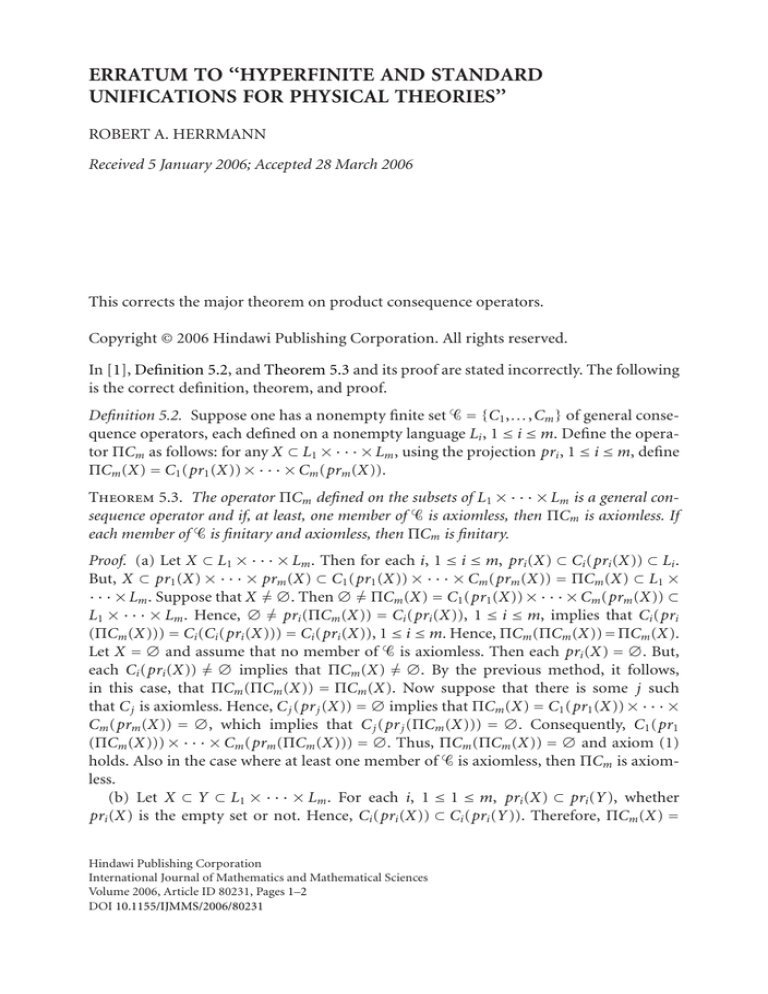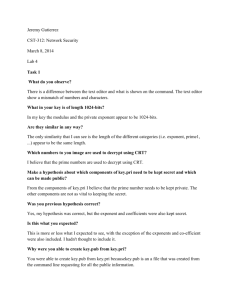
ERRATUM TO ‘‘HYPERFINITE AND STANDARD
UNIFICATIONS FOR PHYSICAL THEORIES’’
ROBERT A. HERRMANN
Received 5 January 2006; Accepted 28 March 2006
This corrects the major theorem on product consequence operators.
Copyright © 2006 Hindawi Publishing Corporation. All rights reserved.
In [1], Definition 5.2, and Theorem 5.3 and its proof are stated incorrectly. The following
is the correct definition, theorem, and proof.
Definition 5.2. Suppose one has a nonempty finite set Ꮿ = {C1 ,...,Cm } of general consequence operators, each defined on a nonempty language Li , 1 ≤ i ≤ m. Define the operator ΠCm as follows: for any X ⊂ L1 × · · · × Lm , using the projection pri , 1 ≤ i ≤ m, define
ΠCm (X) = C1 (pr1 (X)) × · · · × Cm (prm (X)).
Theorem 5.3. The operator ΠCm defined on the subsets of L1 × · · · × Lm is a general consequence operator and if, at least, one member of Ꮿ is axiomless, then ΠCm is axiomless. If
each member of Ꮿ is finitary and axiomless, then ΠCm is finitary.
Proof. (a) Let X ⊂ L1 × · · · × Lm . Then for each i, 1 ≤ i ≤ m, pri (X) ⊂ Ci (pri (X)) ⊂ Li .
But, X ⊂ pr1 (X) × · · · × prm (X) ⊂ C1 (pr1 (X)) × · · · × Cm (prm (X)) = ΠCm (X) ⊂ L1 ×
· · · × Lm . Suppose that X = ∅. Then ∅ = ΠCm (X) = C1 (pr1 (X)) × · · · × Cm (prm (X)) ⊂
L1 × · · · × Lm . Hence, ∅ = pri (ΠCm (X)) = Ci (pri (X)), 1 ≤ i ≤ m, implies that Ci (pri
(ΠCm (X))) = Ci (Ci (pri (X))) = Ci (pri (X)), 1 ≤ i ≤ m. Hence, ΠCm (ΠCm (X)) = ΠCm (X).
Let X = ∅ and assume that no member of Ꮿ is axiomless. Then each pri (X) = ∅. But,
each Ci (pri (X)) = ∅ implies that ΠCm (X) = ∅. By the previous method, it follows,
in this case, that ΠCm (ΠCm (X)) = ΠCm (X). Now suppose that there is some j such
that C j is axiomless. Hence, C j (pr j (X)) = ∅ implies that ΠCm (X) = C1 (pr1 (X)) × · · · ×
Cm (prm (X)) = ∅, which implies that C j (pr j (ΠCm (X))) = ∅. Consequently, C1 (pr1
(ΠCm (X))) × · · · × Cm (prm (ΠCm (X))) = ∅. Thus, ΠCm (ΠCm (X)) = ∅ and axiom (1)
holds. Also in the case where at least one member of Ꮿ is axiomless, then ΠCm is axiomless.
(b) Let X ⊂ Y ⊂ L1 × · · · × Lm . For each i, 1 ≤ 1 ≤ m, pri (X) ⊂ pri (Y ), whether
pri (X) is the empty set or not. Hence, Ci (pri (X)) ⊂ Ci (pri (Y )). Therefore, ΠCm (X) =
Hindawi Publishing Corporation
International Journal of Mathematics and Mathematical Sciences
Volume 2006, Article ID 80231, Pages 1–2
DOI 10.1155/IJMMS/2006/80231
2
Erratum to “hyperfinite and standard unifications”
C1 (pr1 (X)) × · · · × Cm (prm (X)) ⊂ C1 (pr1 (Y )) × · · · × Cm (prm (Y )) = ΠCm (Y )) and axiom (2) holds. Thus, ΠCm is, at least, a general consequence operator.
(c) Assume that each member of Ꮿ is finitary and axiomless and let x ∈ ΠCm (X)
where, since ΠCm is axiomless, X is nonempty. Then for each i, pri (x) ∈ Ci (pri (X)).
Since each Ci is finitary and axiomless, then there is some nonempty finite Fi ⊂ pri (X)
such that pri (x) ∈ Ci (Fi ) ⊂ Ci (pri (X)). Hence, nonempty and finite F = F1 × · · · × Fm ⊂
pr1 (X) × · · · × prm (X). Then for each i, pri (F) = Fi implies that finite F = F1 × · · · ×
Fm = pr1 (F) × · · · × prm (F) ⊂ pr1 (X) × · · · × prm (X). From axiom (2), x ∈ ΠCm (F) =
C1 (pr1 (F)) × · · · × Cm (prm (F)) ⊂ ΠCm (pr1 (X) × · · · × prm (X)) = C1 (pr1 (X)) × · · · ×
Cm (prm (X)) = ΠCm (X). This completes the proof.
References
[1] R. A. Herrmann, Hyperfinite and standard unifications for physical theories, International Journal
of Mathematics and Mathematical Sciences 28 (2001), no. 2, 93–102.
Robert A. Herrmann: Institute for Mathematics and Philosophy, 44890 Rivermont Terrace 100,
Ashburn VA 20147, USA
E-mail address: rah@usna.edu







